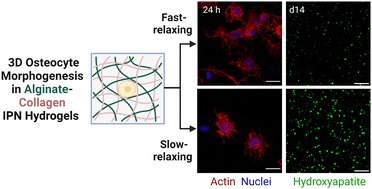Themed collection 33rd Annual Conference of the European Society for Biomaterials

Synthetic and biological nanoparticles for cancer immunotherapy
Nanoparticle battle for the control of the immune tumor microenvironment.

Biomater. Sci., 2024,12, 5933-5960
https://doi.org/10.1039/D4BM00995A
4D hydrogels: fabrication strategies, stimulation mechanisms, and biomedical applications
4D hydrogels mimic anisotropic tissue composition due to non-uniform distribution of internal stresses within them. Herein, we discuss the strategies used to fabricate programmable hydrogels in response to environmental cues for biomedical applications.

Biomater. Sci., 2024,12, 3249-3272
https://doi.org/10.1039/D3BM02044D
Porphyrin-based covalent organic frameworks from design, synthesis to biological applications
Covalent organic frameworks (COFs) constitute a class of highly functional porous materials composed of lightweight elements interconnected by covalent bonds, characterized by structural order, high crystallinity, and large specific surface area.

Biomater. Sci., 2024,12, 2766-2785
https://doi.org/10.1039/D4BM00214H
Porosity dominates over microgel stiffness for promoting chondrogenesis in zwitterionic granular hydrogels
A zwitterionic granular hydrogel with tunable porosity and microgel stiffness is used for cartilage tissue engineering. This chemically-defined biomaterial provides a versatile platform for investigation and optimization of scaffold parameters.

Biomater. Sci., 2024,12, 5504-5520
https://doi.org/10.1039/D4BM00233D
Tunable biomimetic materials elaborated by ice templating and self-assembly of collagen for tubular tissue engineering
Synthetic tubular grafts currently used in clinical context fail frequently, and the expectations that biomimetic materials could tackle these limitations are high.

Biomater. Sci., 2024,12, 3124-3140
https://doi.org/10.1039/D3BM01808C
Enhanced ROS scavenging and tissue adhesive abilities in injectable hydrogels by protein modification with oligoethyleneimine
Tissue adhesive using polyamine-modified gelatin and crosslinker, exhibit scavenging ability of reactive oxygen species and high tissue adhesive strength, shows potential for immunomodulatory hydrogel design, advancing minimally invasive surgery.

Biomater. Sci., 2024,12, 2312-2320
https://doi.org/10.1039/D3BM02065G
Interpenetrating network hydrogels for studying the role of matrix viscoelasticity in 3D osteocyte morphogenesis
3D osteocyte cultures reveal that fast stress-relaxing hydrogels enhance early osteocyte morphogenesis, while slow-relaxing hydrogels favor osteogenic differentiation after 14 days, highlighting their mechanosensitivity to matrix mechanics.

Biomater. Sci., 2024,12, 919-932
https://doi.org/10.1039/D3BM01781H
About this collection
This collection showcases some of the research that was presented at the 32nd Annual Meeting of the European Society for Biomaterials in September 2023. As the official journal of the European Society for Biomaterials (ESB), Biomaterials Science works in partnership with the European Society for Biomaterials to highlight some of the top research from the community. We hope you enjoy reading this collection of featured research.